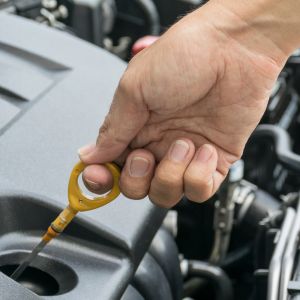Your carâs oil level can be checked and changed on your own; itâs a fairly easy process. To check your carâs oil level, make sure your car is level and has been off for at least a few minutes before you start. Then, find the dipstickâwhich is typically near the front of the engineâand pull it out. The dipstick should be cleaned, reinserted, and pulled out once more. The carâs oil level should be between the minimum and maximum marks on the dipstick, so check it. You will require oil addition if the oil level is low.
To change the oil, youâll need an oil filter wrench, a fresh oil filter, and the recommended grade and quantity of oil for your car. Before adding the new oil, drain the old and swap out the oil filter. For detailed instructions and recommendations on how to check and change your carâs oil, it is always best to consult the ownerâs manual.
Indicators of low carâs oil level

Low carâs oil level can harm your engine and result in expensive repairs. Itâs crucial to regularly check your oil levels and be alert for low oil symptoms. Low carâs oil level are frequently indicated by a number of signs, such as:
- Your carâs dashboard will have a warning light that will flash when the oil level is low. Checking your oil levels right away is crucial if this light comes on.
- If you hear a knocking or ticking noise coming from your engine, it might indicate that your oil levels need to be topped off. Metal components in the engine are rubbing against one another, which can damage them and produce this noise.
- Low oil levels may be indicated if you notice smoke coming from your engine. This may be brought on by oil burning, which is a sign that your engine needs more oil.
- Reduced performance: An engineâs performance may be reduced by low oil levels. It may be a sign that your oil levels are low if you notice that your car is hard to start or is not operating as smoothly as it should.Â
How do I examine and replace my oil?

A relatively easy process that can help your engine last longer is checking and changing the oil in your car. To check and replace your oil, follow these steps:
- Find the dipstick: The dipstick is typically located behind the oil filler cap, close to the front of the engine. It will have a handle or loop at the end for simple removal.
- Pull the dipstick out of the engine with caution, then use a rag to clean it.
- Re-insert the dipstick into the engine and push it all the way in to check the oil level. Next, remove it once more to check the oil level. On the dipstick, the oil level should be in the range between âlowâ and âfullâ. You will need to add more oil if the level is low.
- Assemble the required equipment as previous.
- First refer to your ownerâs manual, to get more on the parts.
- Warm the engine up before changing the oil because the oil flows more easily when the engine is warm.
- Drain the oil: Using the wrench, unplug the oil drain and allow the used oil to flow into the pan. Make sure to properly dispose of used oil.
- The old oil filter should be removed and replaced with a new one using the oil filter wrench.
- Refill with fresh oil by using the funnel to add the advised volume of new oil.
- After refuelling, check the oil level once more, start the engine, and let it run for a few minutes to allow the oil to circulate. Then, check the oil level once more with the dipstick and, if necessary, add more oil.
Can you perform an oil change on your car by yourself?

Yes, you can change your own carâs oil, but youâll need the right tools and a little bit of knowledge. The basic steps for changing your carâs oil are as follows:
- Collect the required equipment as above.
- Find the oil filter and drain plug for the oil: refer to your ownerâs manual because the location of these components can vary depending on your make and model.Â
- Drain the oil: Remove the oil drain plug with the wrench as told previously. Make sure the used oil is disposed of properly.
- Use the funnel to add the recommended quantity of fresh oil to the container to refill it.
- After topping off the oil, check the level, start the engine, and let the oil circulate for a few minutes. Then, use the dipstick to check the oil level and, if necessary, add more oil.
Frequently Asked QuestionsÂ
Q1. Is it possible for you to change the carâs oil level in your car on your own?
Ans: Yes, it is possible to change the carâs oil level in your car by yourself. However, in order to do so correctly and safely, itâs crucial to have the right equipment and knowledge.
Q2. How do I check and replace my oil?
Ans: To check and change your oil, youâll need a few tools, including a wrench, an oil filter wrench, a funnel, a drain pan, and fresh oil and filter. To get specific instructions for your vehicleâs make and model, itâs important to consult the ownerâs manual. In general, you must warm up the engine before locating the oil drain plug and oil filter, taking them out, draining the old oil, changing the oil filter, and adding fresh oil.
Q3. What are the signs of low oil?
Ans: Your car may display a low oil level warning on the dashboard, smell burning oil, make knocking or ticking noises, perform poorly, or even suffer engine failure in extreme circumstances. To make sure your car is performing at its best, itâs crucial to check the level of your oil frequently and refer to the ownerâs manual for the suggested oil change intervals.

